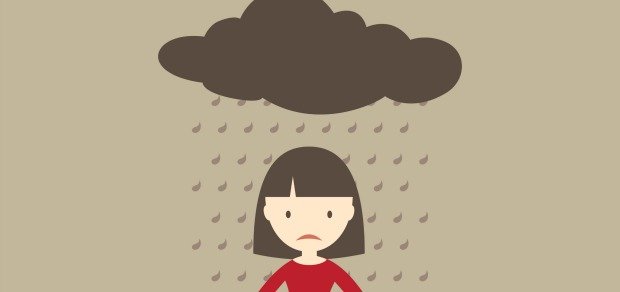
Inside Out is quite possibly the saddest movie Pixar has ever made. In fact, it was so sad that the film’s editors took out at least 20 seconds of the film’s most tear-jerking scene—with Bing Bong and Joy trying to escape the Memory Dump—before it was released to the public, Richard Kind, the voice of Bing Bong, revealed to Yahoo! Movies.
I know I couldn’t have handled 20 seconds more of the lovable imaginary friend’s heartbreaking fade from 11-year-old Riley’s childhood mind. Throw in the Velveteen Rabbit crying in the garden for his owner, E.T. saying goodbye to Elliott and basically any Benji movie, and you’ve got yourself a recipe for a total emotional breakdown. But as the Academy Award-nominated film teaches us, sadness may often get a bad rap, but it’s also an incredibly powerful emotion to have. Here are a few reasons why we should reconsider sadness as an unlikely hero in our lives:
Sadness Can Create Powerful Bonds
“In our culture, we’re tough on sadness, but it’s a powerful trigger for seeking comfort and bonding,” explains one of the film’s psychology consultants, Dr. Dacher Keltner, professor at the University of California Berkeley and co-founder of the Greater Good Science Center.
That’s exactly how Sadness becomes the pivotal character in the movie and the unlikely hero, say two researchers at the Great Good Science Center, Jason Marsh and Vicki Zakrzewski, Ph.D.. “Sadness connects deeply with people—a critical component of happiness—and helps Riley [the film’s protagonist] do the same,” they wrote in Greater Good magazine.
For example, the sadness Riley feels after she misses a potentially game-winning hockey goal elicits overwhelming compassion from her parents and forms a more powerful memory than the happiness she’d feel if she’d made the goal, Marsh and Zakrzewski say. Later in the film, Riley becomes overwhelmed with the different feelings she’s experiencing and she begins to withdraw all emotion. But the one emotion that breaks through and reunites the pre-teen with her parents is sadness. In this case, Sadness was a more powerful emotion than Joy—and it was also Riley’s catalyst for achieving happiness.
Sadness Causes Us to Evaluate Our Emotions
Just like the character Sadness can turn a bright, happy memory orb the color blue by simply touching it, sadness as an emotion can move an otherwise content moment into an uncomfortable place that leaves us in emotional limbo. As Sadness says in the film, “Crying helps me slow down and obsess over the weight of life’s problems.”
When you’re happy, do you stop to evaluate why you feel happy? I don’t usually. But knowing the ups and downs I’m prone to feel, I don’t want to look a gift horse in the mouth. Let me keep gumming peanut butter for a smile, because I know I won’t always feel so good, confident and full of self-esteem.
But when you’re sad, you rack your brain to figure out why you don’t want to put on pants and face the day. Sadness and melancholy causes you to examine your feelings and look inward to help figure out the reason why, as uncomfortable as that can be.
Sadness Forces Us to Practice Mindfulness
The movie’s opening line is “Do you ever look at someone and wonder, ‘What is going on in their head?’” But how often do you wonder what is going on in your own head?
Psychologists say the ability to identify and manage emotions is emotional intelligence at work, and existing in this space is something they often call mindfulness. I tried this recently when I couldn’t figure out why I felt so overwhelmingly melancholy for days at a time. I wanted to feel better, so
I tried to evaluate all the different elements that affect my mood and mind: my career, relationships, diet, sleep and level of activity, among other things. Of course, I didn’t realize I was practicing mindfulness; I simply wanted to get out of the dumps, just as Joy and Bing Bong found themselves trying to escape the Memory Dump, only to slide back down a mountain of slippery orbs.
Simply starting to pay attention to these things was an important first step to feeling better, but it wasn’t joy, anger or disgust that helped me get there. It was the emotion of sadness that set me on this journey of self-awareness.
On my journey, I discovered fear was at the helm of my mind’s control panel. Fear of doing something new and unlike me—being a more public persona for SUCCESS.com—was making a mess of my confidence and self-esteem, and left the door open for insecurity and negative thoughts to sneak onto the control panel. Once those emotions had run my mind off-course, I felt sad and depressed. As Inside Out teaches us, feeling sad was the emotional wake-up call I needed to get back on track.
It sounds funny to say that sadness is the catalyst emotion that’ll make you feel better, but it’s true. Inside Out helps explain how positive and negative emotions bump up against each other in our everyday lives, why that’s normal, and how ultimately, emotions team up to solve a problem in our lives.
You can learn all that from a film that features a pink cotton candy creature named Bing Bong, who has a cat tail, an elephant trunk and dolphin torso. Oh, and he cries candy when he’s sad. If only we could all do that.
Originally published at www.happify.com
Shelby Skrhak is a freelance writer and host of Secret to My Success podcast. She’s a southpaw and her handwriting should be a font. Find her on Twitter @ShelbySkrhak.


